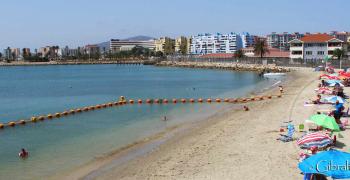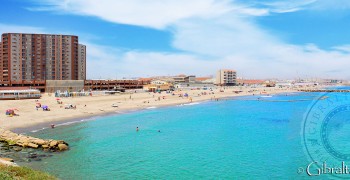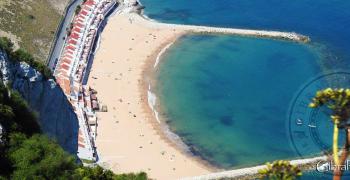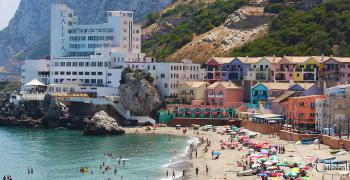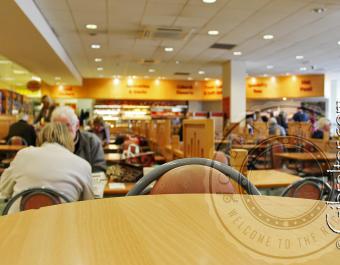Although the history of the Rock of Gibraltar stems back 100,000 years ago to when primitive man and Neanderthals inhabited the area, it was the Moors of Tarik ibn Ziyad that first settled on the Rock back in 711AD, officially naming it Jebel-Tarik, the mountain of Tarik.
The years passed as they do, and a mosque had been built to offer up prayers, a place of worship for themselves. The mosque was built, or so it seems to historians, sometime prior to 1309, at the most southerly tip of the land of Gibraltar.
The Shrine of Our Lady of Europe in Gibraltar with the Virgin Mary and Jesus sitting on her lap.
August of 1462 saw the Spaniards of Don Rodrigo Ponce de Leon capture Gibraltar from the Moors and they left with finality this time. The small mosque was converted post haste into a shrine to the Lady, to honor Our Lady as Patroness of Europe, with the firm intent to devote all of the continent to their God. A large chapel was built near the mosques eastern wall and the entire area became the “Shrine of Our Lady of Europe.”
Not long after this, there was installed a statue of the Virgin and her child, diminutive in nature, just two feet tall, carved from wood and colored royal blue, gold and red. Seated with the baby Jesus on her lap, the Virgin mother held a scepter with three flowers, each given a different meaning, Love, Justice and Truth.
Sailors asked, and were granted that a light could be kept burning for them, not just in the front of the image of Mary and the Baby, but also in the tower, and the ships between them made provisions that the small chapel never be without oil, a constant supply guaranteed to them for their lights. The mariners and others were also, according to the writings of the time, given special favors when they “invoked her name”.
Interesting Fact
The Shrine of Our Lady of Europe became very famous. Over the centuries it was revered by soldier, sailor and pirate alike for what it offered to them. It became so popular for the light that it afforded the ships that the men who sailed past stopped to salute the Lady and very often gave gifts to those who were in residence as they sailed past Europa Point.
It was, as has been noted, a time of unrest for the area, and of multiple sieges for Gibraltar, as well as piracy and other such events in these waters. Each year Gibraltar would take many raids from pirates, primarily Turkish, but also others, and among the most famous, or perhaps infamous is a better word, was that which took place on the 10th of September in 1540.
Outside photograph of the tower of the Shrine of Our Lady of Europe in Gibraltar.
The corsair, Hali Hamat, commanded by one of a captains of the Pirate Barbarossa who was guided there by an Italian named Caramanli, took the shrine, robbing it of every valuable item that was in the possession of the shrine, and then, moving into the town, captured many people to be sold as slaves.
They then tried to enter the cathedral but found it well guarded by a priest, Francisco Saavedra. They sailed away without the cathedral goods, but did have many treasures from the shrine as well as their captives.
The Spanish fleet, at that time under the command of Bernardino Mendoza, pursued and clashed with them near Cartegena. The pirates were defeated, and Caramanli was killed in this battle. The razing of the shrine led to a letter being sent to the King of Spain, Charles V, by a hermit who lived at the shrine.
Charles V, as history recalls, did exactly nothing, but the letter was answered, when his son Phillip II had very thick tall walls installed around it, making it a refuge for the towns people when there was a need for it. A Spanish historian, Portillo, in the 17th century, tells of how richly decorated and well cared for the shrine was and how many miracles were said to have taken place there.
The fourth of August in 1704, saw Gibraltar captured by the British, commanded by Admiral Rooke. The Shrine of Our Lady of Europe was stripped completely of every valuable by the landing Marines and the Virgin and Child were flung down to the rocks below, but oddly enough, or perhaps not, as it was made of wooden construction, the pieces were found by a fisherman, having floated, and taken to father Figueroa, who placed the pieces of the statue in Algeciras where it was safeguarded.
The shrine was not now a place of worship, but instead, nearly decayed, being damaged badly during the Great Siege, but the Gibraltar people continuously requested the return of the statue, so a model of it was made, and decorated by the people with various gemstones and taken to the cathedral. That model still holds multiple small holes that held the gems in place on the neck of the Lady.
Depiction of the mass exodus from Gibraltar in August 1704 by Jose Antonio Valdes.
Also around this time, the devoted to the shrine formed a group of sorts and organised treks to the shrine, and offered money for those who had died without enough to be buried. 1779 during the great siege, the caretaker, Father Mesa, who saw that the Cathedral was on fire, took the statue to Windmill Hill flats were numerous towns people had sought shelter.
The original of course still remained in Algeciras, until 1864 when the Bishop Scandella, assisted by Pope Pius attained permission to replace the image in Gibraltar. On the day that it was returned to the Shrine, the entire route was lined with the army as the procession moved from Waterport to the Franciscan Convent, opposite what is now the Government House.
Gibraltar’s issues too, were taken an interest in during the First Vatican Council, when that same Bishop Scandella won the Pope’s enthusiastic in the shrine of Our Lady of Europe and he offered to see built a temporary chapel which was completed in May 1866. The Pope donated the marble for the altar. The front piece of the altar depicted the coat of arms of Pope Pius IX and Bishop Scandella, along with a monogram of Our Lady. As the war ensued, in 1939 the image was taken to the Cathedral to be safeguarded.
The shrine, in the meantime, had been further decimated by being used as a storehouse for oil for the army. In 1910, E.R. Kenyon described the shrine, in a book about Gibraltar, as “an ugly little building which stands among the army barracks.”
Records state that in 1928 it was being used as a library for the garrison of Gibraltar. In the Second World War it again became a store house.
The Marian Year –1954– on the evening of Sunday 15th August, the Feast of the Assumption, a torch-lit procession took place and the image of Our Lady was moved from the Cathedral to St Joseph’s Church, which was at the time the nearest parish church to the shrine.
Photograph of inside the Shrine of Our Lady of Europe in Gibraltar.
1959 saw the military with no more use for the Shrine building and it was decided to demolish it, and it would nearly have been accomplished, had it not been for the efforts of just a few. It was saved by being named an ancient monument and was preserved for those reasons.
The restoration began in 1962 and on the 28th September of that same year, Bishop Healy celebrated the first Mass at the shrine after 258 years. The first Baptism was held in November 1966 and the first wedding was celebrated in July 1976.
On the 7th October 1968 the statue of Our Lady was restored to the shrine, in a public procession from St Joseph’s Church.
On the Tenth of September 1995, Gibraltar’s National Day, plans were revealed for more renovation and further refurbishment of the Shrine.
Those plans included building an extension, an office, museum and a tower. The restoration was funded by the European Commission and the Gibraltar Government. Additionally, for fund raising, a set of gold, silver and nickel commemorative medals were produced to be sold.
The Pope, is said to have taken a particular interest in the proposed renovation and sent the following letter to the Bishop.
From the Vatican, 6th September 1995
My Lord Bishop,
The Holy Father was pleased to be informed of the ceremonies to be held at the Shrine, set up by King Ferdinand IV in the year 1309 and dedicated to the Mother of Christ under the title of Our Lady of Europe. He has noted with particular interest that the venerable building is currently being extended and refurbished as a more worthy focus of the Marian devotion of the people of Gibraltar and of the many pilgrims from elsewhere in Europe and beyond.
At a time when the unity of the continent of Europe is being fostered and strengthened, it is indeed appropriate that Gibraltar should house such a potent symbol of such unity, which belongs not only to the civil and political level but is also and specially a reality in the spiritual sphere.
It is the prayer of His Holiness that the Shrine will be an ever effective centre of unification, a place where, under the patronage of Mary, the human family will be drawn ever more closely into fraternal unity and peaceful coexistence.
With these sentiments the Holy Father invokes abundant divine graces upon those gathering for the religious observances, and with affection in the Lord he imparts his Apostolic Blessing to you and to the whole Church in Gibraltar.
With fraternal best wishes, I remain
Yours in Christ
G.B.RE
Gibraltar’s Shrine of Our Lady of Europa has seen vast changes, vast decay trials and sieges, watched as they all passed with time. She sits now, restored to her former glory, offering testament to Gibraltar’s spirit. The Shrine now shines as it once did, watching over the tip of the continent.














